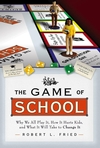The Game of School
By Murray Bourne, 19 Sep 2005
By Robert L. Fried, John Wiley & Sons, 2005.

Summary Review
In The Game of School, Fried gives us an excellent exposé on what's wrong with a lot of institutional education today. In many schools, very little authentic or meaningful learning goes on, because the Game of School takes over. That Game involves:
- A curriculum that is impossible to get through and does not relate to students' lives,
- Assessments that are aced by rote learning and/or intelligent guessing,
- Unmotivated students who do the bare minimum to scrape a pass,
- "Fun" being defined as how upset we can make the teacher,
- A lot of wasted time,
- Product ("doing the work") being a more important outcome than learning how to learn,
- When assessment scores are returned to students, "Whadja get?" is more important than "Whadja learn?"
- Fudging of marks to make the distribution look right
Power
Fried argues that the Game is most prevalent when students have little control over their learning. In one study into this,
...one researcher gave up as there was no evidence at all that students were invited to offer their suggestions for [class] rules (p64)
Fried goes on to say:
"Learning and power are inextricably linked. Powerless students often learn only that learning in school has little to offer them." (p65 )
Fried (p82) suggests 7 Categories of Learners as a discussion starter (and I paraphrase):
- True-blue learners (love school and learning)
- Go-getters (high grades are the only important thing)
- Cherry pickers (only do anything in classes they like)
- Pluggers (try hard)
- Rebels & Jokers (hate school and joke around)
- Socialites (school is a place to meet friends)
- Give-uppers (those who can't cope)
Which category are our students in and what are we doing to make them like that?
Curriculum
Many educators are overwhelmed with the amount of material they need to teach.
...the curriculum is loaded with so much material that it can only be "covered" through constant lecturing and note-taking... Game-playing artificiality replaces authenticity, and enduring learning falls by the wayside. (p122)
... and ...
... it is more economical to tell a group of [students] how to do something... But experience shows us that such instructional efficiency comes at a price: we see inattention, uncaring and forgetfulness among learners. (p127)
Assessment
The US continues to suffer angst over the No Child Left Behind policy. While something needs to be done about education, the US is now facing the problem that assessment-driven systems have had for years...
The NCLB policies are leading to a new form of the Game of School, "teaching to the test". (124)
And more from a student...
We know why she's telling us what's gonna be on the test; it's because she wants us to do good, so she'll look good" (p130)
Aims and the Passion of Learning
Real, authentic learning comes from doing what you are passionate about.
Instead of expressing learning objectives in terms like "By the end of this semester, students will be able to discuss stereotypes.", Fried suggests we should address the students directly, something like,
"Do any of you think that you behave in a certain way because you are Asian, Black, White or Mixed?" (p185).
I recommend The Game of School to any educator that feels something is seriously wrong with current educational approaches. The book is an easy read since it avoids jargon and is sprinkled with interesting anecdotes and case studies.
The Game that Fried describes is such a waste of time and resources. Let's move away from an obsession about test scores, and let's have an obsession about learning.
See the 2 Comments below.
